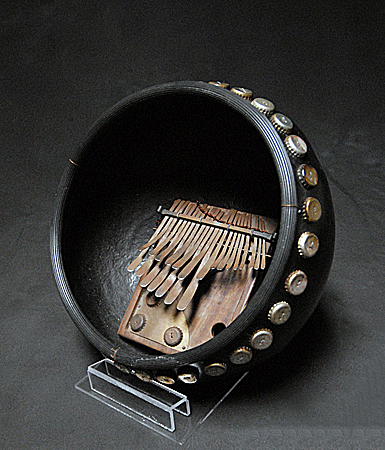
Owner: HWMC
Catalog#: AF-IDPL-27-14
Provenance: Alan Suits, Coyotes Paw Gallery
Lamellophones
Shona 'Mbira dza vadzimu'
Zimbabwe
Shona
Wood, calabash, metal bottle caps, metal,
Mid 20th Century
Length: 10 in, Depth: 8.5 in
Idiophone – Lamellophones – Plucked
The body of the Zimbabwe/Zambezi lamellophones are always cut from a single piece of wood. As is suggested by its name dza vadzimu (of the ancestral spirits) this mbira was used long ago in the context of religious ceremonies for the ancestors. This mbira dza vadzimu has twenty-nine (29) metal tongues (notes) arranged in two ranks and is held into a large hemispheric gourd resonator called a deze. Bottle caps are sewn around the gourd’s rim that produce a buzzing sound when the metal tongues are played.
The mbira dzavadzimu (‘mbira of the ancestors’), is also known as the nhare mbira (‘iron mbira’). It is a plucked lamellaphone idiophone of the Zezuru Shona people of Zimbabwe. This instrument is closely associated with traditional spirit possession ceremonies. These ceremonies, known as bira, are the primary context in which the mbira dzavadzimu is played, but it also has come to be incorporated in other settings more secular in nature. In recent decades, this instrument has become the most widely known form of Zimbabwean lamellaphone. This rise to prominence is often associated with the surge in nationalism that led to the Zimbabwean independence struggle of the 1970s. Music played on the mbira dzavadzimu became a source of nationalistic pride and came to index indigenous identity. The secularization and popularization of the mbira dzavadzimu continued after the independence movement as popular music groups began to incorporate traditional musical instruments and styles into contemporary musical forms. This synthesis of traditional and popular music was most notably done by Thomas Mapfumo. As the focus of scholarly writings and recordings published by American ethnomusicologist Paul Berliner in the 1970s, the mbira dzavadzimu came to the attention of an international audience.
The mbira dza vadzimu is played by plucking the long narrow tongs with the thumbs and forefingers. There is a minimum of two parts played on this instrument. The lead part, known as the kushaura, is most often played in the higher range of the instrument. The kutsinhira, is typically played on the lower-pitched keys of the instrument. These two parts interlock and overlap to create polyrhythm.
Source: mbira dzavadzimu · Grinnell College Musical Instrument Collection · Grinnell College Libraries
